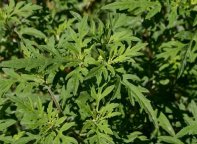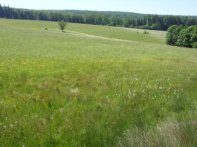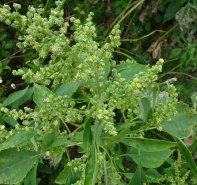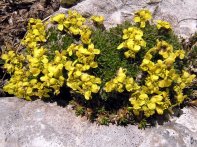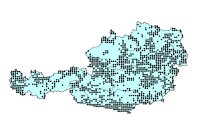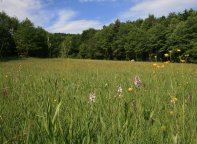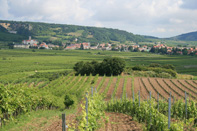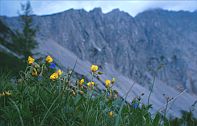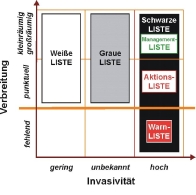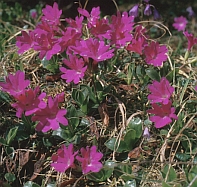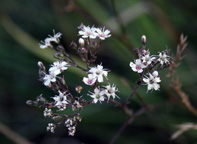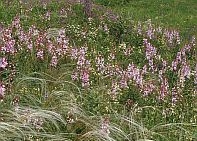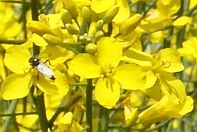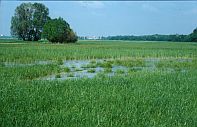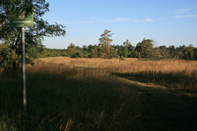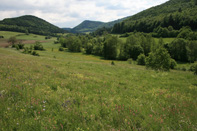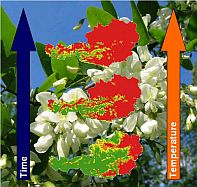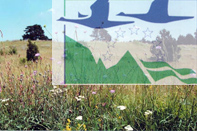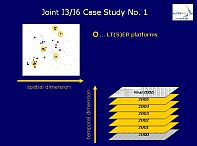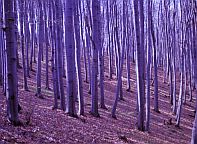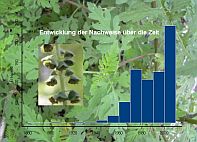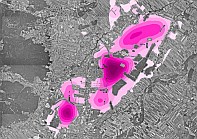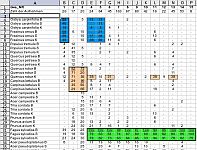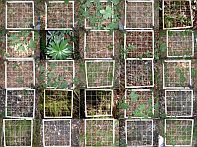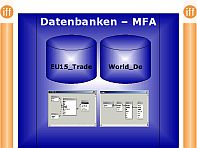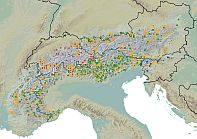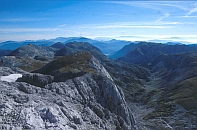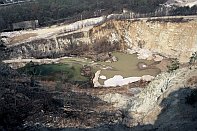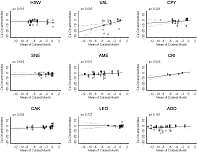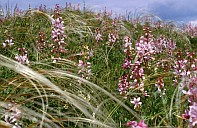| |
|
| |
| Climate
effects on the recent range expansion of ragweed in Central Europe (RAG-Clim) |
|
|
Recent range expansions of invasive species in
temperate regions have repeatedly been attributed to climate warming.
However, other invasion drivers like increased rates of travel and
transport or changes in land use patterns might also be responsible
for these range dynamics. Isolation of the effects of different
factors is hampered by the availability of appropriate analytical/modelling
tools. In this project, we will design and implement such a tool
as a spatially explicit generalized survival model with a modular
structure to account for various potentially driving processes.
The model will be embedded in a Bayesian framework with parameter
estimation algorithms based on Markov-chain-Monte-Carlo-simulations.
We will then use this framework to assess and quantify the role
of climate warming for the range dynamics of the invasive allergenic
weed Ambrosia artemisiifolia in central Europe since the mid of
the 20th century.
| Funding: |
Austrian Research Panel on Climate
Change (ACRP) |
| Project start: |
July 2011 |
| Project time: |
28 months |
| Contact: |
Stefan
Dullinger |
|
|
| |
|
| |
| Evaluating
the zonation of the Biosphere Reserve Wienerwald: How well does the
conservation zone contribute to biodiversity conservation? |
|
|
The delimitation of the conservation zone was
done in 2004, based on available data as well as on recommendations
of a local advisory board, but without field work. With the proposed
project, we want to address the following questions: (1) Are there
significant differences in the biodiversity and conservation value
of meadows inside and outside the conservation zone in the Biosphere
Reserve Wienerwald? (2) Do areas inside and outside of the conservation
zone differ in habitat diversity and composition? (3) Did changes
in agricultural land use practices affect the biodiversity of meadows
in the Biosphere Reserve Wienerwald, and what are the implications
for management and conservation of grasslands? The results will
lead to a decision guidance for the management of the biosphere
reserve Wienerwald with regard to a possible re-evaluation of the
delimitation of the conservation zone and with regard to management
and conservation of meadows.
| Funding: |
Austrian Academy of Science
(Man and Biosphere Programm) |
| Partners: |
AVL - ARGE Vegetationsökologie und Landschaftsplanung
GmbH
Biosphere Reserve Wienerwald Management
|
| Project start: |
May 2011 |
| Contact: |
Wolfgang
Willner |
|
|
| |
|
| |
| CLIM-Allergy
- Modelling the invasion potential and socio-economic impact of allergy-inducing
plants in Austria in relation to climate change |
|
|
This is a collaborative project led by the Austrian
Agency for Health and Food Safety with the Federal Environment Agency
and the Department of Economics, University of Klagenfurt, as additional
partners The objectives of the project are to model the future distribution
of the allergy-inducing plant species Iva xanthiifolia, Artemisia
annua and Ambrosia trifida in Austria and neighbouring European
countries based on their current distribution and the reconstruction
of their invasion history. A cost-benefit analysis of different
containment and control options is used to provide recommendations
for a proactive management strategy for relevant stakeholders and
policy-makers.
| Funding: |
Austrian Research Panel on Climate
Change |
| Project start: |
January 2011 |
| Project time: |
24 months |
| Contact: |
Stefan
Dullinger |
|
|
| |
|
| |
| Climate
change and endemic plants - Range dynamics of endemic Austrian mountain
plants under climate change |
|
|
The objective of the proposed project is to evaluate
range shifts, and in particular range reductions, of endemic Austrian
plants by means of a new, spatio-temporally explicit modelling approach,
i.e. a migration model. We we will parameterize this model for a
selected subset of ~ 30 endemic vascular plants and apply it to
predict the spatio-temporal dynamics of the populations of these
species within the Austrian Alps until the end of the 21st century
under different climate change scenarios.
| Funding: |
Austrian Academy of Sciences |
| Project start: |
June 2010 |
| Project time: |
36 months |
| Contact: |
Stefan
Dullinger |
|
|
| |
|
| |
| Flora
of Austria |
|
|
Editorial supervision of the “Critical
Flora of Austria”.
| Funding: |
Austrian Academy of Science
Federal Ministry of Environment - Global Strategy for Plant
Conservation (GSPC) |
| Partner: |
Prof. Dr. Manfred A. Fischer
University of Vienna
|
| Project start: |
June 2004 |
| Contact: |
Wolfgang
Willner |
| |
|
| » Homepage
& Online-Flora |
|
|
| |
|
| |
| Austrian
Vegetation Database |
|
|
The aim of the Austrian Vegetation Database
is to gather computerized phytosociological information (vegetation
relevés) from the territory of Austria.
| Funding: |
various |
| Partners: |
Prof. Dr. Georg Grabherr
Prof. Dr. Gert Michael Steiner
Prof. Dr. Paul Heiselmayer
|
| Project start: |
1997 |
| Contact: |
Wolfgang
Willner |
| |
|
| » Homepage |
|
|
| |
|
| |
|
| |
|
| |
FINISHED
PROJECTS |
|
|
| |
|
| |
Diversity
and conservation value of the meadows and dry grasslands in the Biosphere
Reserve Vienna Woods - pilot study
|
|
|
The meadows and dry grasslands in the Biosphere
Reserve Vienna Woods (Wienerwald) are among the richest in Eastern
Austria. In this project, a new survey of the grassland types in
the Biosphere Reserve will be elaborated. All existing relevés
will be gathered in a TURBOVEG database, and more than 200 new relevés
will be sampled in the field. Additional project aims are a mapping
key, a cross-walk to EU habitat types, and the establishment of
a grassland database. This is a pilot study for a future mapping
of the grasslands within the Biosphere Reserve.
| Funding: |
Austrian Academy of Science
(Man and Biosphere Programm) |
| Partners: |
AVL - ARGE Vegetationsökologie und Landschaftsplanung
GmbH
Biosphere Reserve Wienerwald Management
|
| Project start: |
Project start: March 2010 |
| Contact: |
Wolfgang
Willner |
| |
|
|
|
| |
|
| |
WBL
(Weinbaulandschaften)
Viticultural Landscapes in the Biosphere Reserve Wienerwald
|
|
|
To grow wine on the easternmost border of the
Alps, the so-called Thermenlinie, has a very long tradition. The
cultural landscape is complex with thermophilious forests, dry grasslands
and agriculture. The aim of the project is to foster sustainable
land use with special regard to biodiversity values within this
old cultural landscape.
| Client: |
Biosphere Reserve Wienerwald
Management |
| Partners: |
Dr. Irene Drozdowski
|
| Project start: |
January 2008 |
| Contact: |
Norbert
Sauberer |
| |
|
|
|
| |
|
| |
ECOCHANGE
Challenges in assessing and forecasting biodiversity and ecosystem
changes in Europe |
|
|
| Funding: |
European Commission |
| Partners: |
22 Partners
Co-ordination:
Pierre Taberlet, University of Grenoble
|
| Project start: |
January 2007 |
| Project time: |
60 months |
| Contact: |
Stefan
Dullinger |
| |
|
| » Homepage |
|
|
| |
|
| |
NEOBIOTA
AND CLIMATE CHANGE
Black list and Habitat Models |
|
|
The co-operation between Germany and Austria
leads to a so called black list of the most harmful non-native species
in both countries. Two groups – fish and higher plants –
are in focus. The list includes species which are proofed to be
a threat to native biodiversity and ecosystems by now as well as
species which are expected to invade native habitats and thereby
influence species communities negatively if allowed to spread. “Fact-sheets”
are produced for this selected set of species. The major objective
for work package 3 (VINCA-part of the project) is to model the potential
habitats for all the plant species on the black list. Based on the
current habitat preferences we predict endangered areas in Germany
and Austria under various climate change scenarios to provide support
for the development of prevention- and eradication programs.
| Funding: |
BfN – Federal Agency for Nature Conservation, Germany
(UFOPLAN: F+E Vorhaben - FKZ: 806 82 330)
|
| Partners: |
UBA – Federal Environment Agency, Austria
Co-ordination:
Dr. Franz Essl & Dr. Wolfgang Rabitsch
|
| Project start: |
January 2007 |
| Project time: |
3 Years |
| Contact: |
Ingrid
Kleinbauer |
| |
|
| » Link
UBA |
|
|
| |
|
| |
FLORALP
Ecological versus historical deteminants of plant species distribution
in the Austrian Alps |
|
|
There is increasing awareness that many plant
species are not in equilibrium with their current environment. In
the present study we want to examine (1) the extent to which plant
species of alpine grasslands fill their potential range as predicted
by habitat distribution models which are based on the assumption
that species are in equilibrium with current environmental conditions,
and (2) if differences in range filling can be explained by species
functional traits. Distribution models will be derived by linking
spatially explicit data of species presence and site environmental
data on climate, geological bedrock, and topography. Quantification
of range filling will be done by comparing the modelled distribution
with data of the floristic inventory of Austria.
| Funding: |
Austrian Academy of Science |
| Partners: |
Dr. Hans-Georg Krenmayr
Geological Survey of Austria
Univ.-Prof. Dr. Georg Grabherr
Dep. of Conservation Biology, Vegetation and Landscape Ecology
University of Vienna
em. Univ.-Prof. Dr. Harald Niklfeld
Ass.-Prof. Dr. Luise Ehrendorfer-Schratt
Dep. of Biogeography
University of Vienna
|
| Project start: |
September 2007 |
| Project time: |
34 months |
| Contact: |
Stefan
Dullinger |
|
|
| |
|
| |
HANNA
Priorization of nature conservation measures in Lower Austria
|
|
|
Lower Austria is the most biodiverse province
of Austria, but many plants and animals are threatened. Funding
is limited and there is an urgent need to focus on the subset of
species for which Lower Austria has the greatest responsibility.
A standardised analysis will create the basis for priorization up
to 2020.
| Client: |
ARGE Handlungsbedarfsanalyse
Naturschutz (Büro LACON / Büro Bieringer) |
| Partners: |
Dr. Georg Bieringer, Klaus Wanninger, Dr. Klaus-Peter Zulka,
Dr. Barbara Gereben-Krenn, Johannes Frühauf
|
| Project time: |
July 2008 - 2010 |
| Contact: |
Norbert
Sauberer |
| |
|
|
|
| |
|
| |
BIOSTRAT
Developing the EU Biodiversity Research Strategy |
|
|
The main objective of BIOSTRAT is to support
the further development of a European Biodiversity Research Strategy.
Such Research Strategy brings together ideas on research priorities
in fundamental and applied sciences to address critical gaps in
knowledge on the conservation and sustainable use of biodiversity.
| Funding: |
European Commission |
| Partners: |
20 Partners
Co-ordination:
Dr. Katalin Török, Institute of
Ecology and Botany of the Hungarian Academy of Sciences
|
| Project start: |
November 2006 - 2010 |
| Project time: |
36 months |
| Contact: |
Norbert
Sauberer |
| |
|
| » Homepage |
|
|
| |
|
| |
BINATS
Evaluation of floristic and faunistic biodiversity in agricultural
regions - baseline data for an ecological risk assessment of future
releases of genetically modified crops in Austria |
|
|
The study comprises the inventory and analysis
of biodiversity in representative agricultural regions (fields,
fallows and adjacent habitats) in Austria by means of appropriate
indicator groups. These indicators include vegetation, butterflies,
grasshoppers and landscape structures. These data should serve as
a baseline (status quo) to recognize negative effects in an ecological
risk assessement of potential future releases of genetically modified
crops. They could be used as basic data for case specific investigations
(evaluation of the specific crop, the trait, regional aspects, etc.)
as well as for general surveillance. Altogether, 100 test areas
distributed all over Austrian agrarian landscapes will be investigated
for biodiversity with a special focus on cultivation areas of maize
and oilseed rape.
| Client: |
University of Vienna:
Prof. Dr. Georg Grabherr
Dr. Kathrin Pascher |
| Project start: |
January 2006 -2010 |
| Project time: |
4 years |
| Contact: |
Dietmar
Moser |
|
|
| |
|
| |
| LIFE
project Feuchte Ebene |
|
|
Feasibility study for a LIFE project in
the Feuchte Ebene (Lower Austria).
| Client: |
Wasserleben-Fonds (VERBUND)
and Naturschutzbund Österreich |
| Partner: |
Naturschutzbund Niederösterreich |
| Project start: |
March 2005 - 2010 |
| Contact: |
Norbert
Sauberer |
|
|
| |
|
| |
| Modeling
the Global HANPP |
|
|
Development of a GIS environment and a
database solution to calculate a spatial explicit model of the global
Human Appropriation of Net Primary Production for the year 2000.
| Client: |
IFF - Department Social Ecology
/ University Klagenfurt |
| Partner: |
Firmix Software GmbH |
| Project start: |
October 2004 - 2008 |
| Contact: |
Christoph
Plutzar |
|
|
| |
|
| |
| Evaluation
of Nature Reserves in Lower Austria |
|
|
Since the 1920ies nature reserves were established
in Lower Austria. Now, more than 60 reserves exist. Some reserves
are well-managed, others are poorly known. The aim of the project
is to recapitulate the knowledge about the nature reserves and to
give recommendations for their future management.
| Client: |
Umweltbundesamt GmbH
Co-ordination: Dr. Thomas Ellmauer |
| Partners: |
Naturschutzbund Niederösterreich
|
| Project time: |
January 2007 - December 2008 |
| Contact: |
Norbert
Sauberer |
|
|
| |
|
| |
| Conservation
value of meadows in the Vienna woods |
|
|
About 700 hectares of meadows in the Biosphere
Reserve Vienna woods (Wienerwald) belong to the company Austrian
Federal Forests (Österreichische Bundesforste - ÖBf).
During the course of the project these meadows were mapped according
their floristics and vegetation types. The conservation value of
every single meadow was assessed. Additionally, recommendations
for their future management were developed.
| Client: |
Österreichische Bundesforste
(ÖBF)
Co-ordination: DI. Gerald Oitzinger |
| Partners: |
Naturschutzbund Niederösterreich
|
| Project time: |
January 2007 - December 2008 |
| Contact: |
Norbert
Sauberer |
|
|
| |
|
| |
| Climate
change impacts on potential distribution and landscape-scale dynamics
of Robinia pseudacacia L. in Austria |
|
|
This project has two main objectives: a) providing
a regionalised assessment of black locust (R. pseudacacia)
invasion risk in Austria under scenarios of forthcoming climate
change by means of predictive habitat modelling. b) We experimentally
evaluate the effects of interacting global change components (climate
change and nitrogen deposition) on the colonisation of new habitats
by individuals recruiting from seeds while taking into account competition
with a native tree, the sessile oak (Quercus petrea).
| Funding: |
Austrian Academy of Science |
| Partners: |
Dr. Franz Essl, UBA
Dr. Johannes Peterseil, UBA
Mag. Thorsten Englisch, University of Vienna
|
| Project start: |
June 2005 |
| Project time: |
3 years |
| Contact: |
Ingrid
Kleinbauer |
|
|
| |
|
| |
| Article
17 report on the conservation of natural habitats and of wild fauna
and flora (Council Directive 92/43/EEC) |
|
|
In the framework of the Article 17 report of
Austria VINCA is responsible for the vascular plants, amphibians
and reptiles.
| Client: |
Umweltbundesamt GmbH
Co-ordination:
Dr. Thomas Ellmauer |
| Partners: |
28 Partners
|
| Project start: |
March 2007 |
| Project time: |
3 months |
| Contact: |
Wolfgang
Willner |
|
|
| |
|
| |
AlterNet
case study No.1 in WP I3/I6:
Collation and analysis of vegetation and climate data from LTER sites
across Europe" |
|
|
The case study aims in documenting and analysing
the networking and communication processes within the EU- Network
of Excellence by testing the network abilities to provide distinct
long-term-ecological data on tree regeneration across Europe.
| Funding: |
EU NoE AlterNet |
| Partners: |
Dr. Michael Mirtl, UBA
Dr. Johannes Peterseil, UBA
Dr. Chris Thomas, GB
Rebecca Ledger, GB
|
| Project time: |
July 2006 - September 2006 |
| Contact: |
Ingrid
Kleinbauer |
|
|
| |
|
| |
| Sustainable
biomass use in the Biosphere Reserve Wienerwald |
|
|
The project aims in an amelioration of knowledge
in the quantification of biomass actual available, in the consequences
of an increased biomass use for the nutrient cycle, in the sustainable
management of dead wood and veteran trees for biodiversity and in
an estimation of the potential of a sustainable biomass use.
| Funding: |
Austrian Academy of Science |
| Partners: |
Dr. Eduard Hochbichler, BOKU
Dr. Norbert Milasowszky, Vienna
Dr. Leo Sachslehner, Vienna |
| Project time: |
February 2006 - November 2006 |
| Contact: |
Norbert
Sauberer |
|
|
| |
|
| |
| An
allergenic neophyte and its potential spread in Austria - range dynamics
of ragweed (Ambrosia artemisiifolia) under influence of climate
change |
|
|
Ragweed is an introduced annual plant species
highly problematic with respect to human health due to ample production
of allergen pollen This project aims at estimating the extent of
range expansion of A. artemisiifolia in Austria under forecasted
climate warming. Based on the climatic envelop of the current Ambrosia
range we simulate range shifts driven by potential climate change.
Across Austria, this approach will allow for assessing the regionally
varied risk of Ambrosia under a warmer climate.
| Funding: |
Startclim2005-program |
| Partners: |
Dr. Franz Essl, UBA
Dr. Johannes Peterseil, UBA
Mag. Thorsten Englisch, University of Vienna
|
| Project time: |
January 2006 - October 2006 |
| Contact: |
Ingrid
Kleinbauer |
|
|
| |
|
| |
| Habitat
Modelling of the Stone Curlew |
|
|
Spatial modelling of the impact assessment
on the habitat of the Stone Curlew (Burhinus oedicnemus) due to
a planned road construction (B17 by-pass, Lower Austria).
[short info]
| Client: |
Dr. Hans Peter Kollar, Techn.
Büro für Biologie |
| Partner: |
Dr. Georg Bieringer, Leobersdorf |
| Project time: |
March 2004 - May 2005 |
| Contact: |
Christoph
Plutzar |
|
|
| |
|
| |
| Forest
types in Carinthia |
|
|
Data acquisition and classification of
vegetation samples for an expert system of the natural forest types
in Carinthia (Southern alps & Klagenfurt basin).
|
|
| |
|
| |
| Repetition
of the “Zöbelboden” inventory |
|
|
Repetition of the first vegetation inventory
at the UNECE Integrated Monitoring Site Zöbelboden.
| Client: |
Umweltbundesamt GmbH |
| Partner: |
Univ.-Prof. Dr. Gerhard Karrer |
| Project time: |
June 2004 - June 2006 |
| Contact: |
Ingrid
Kleinbauer |
|
|
| |
|
| |
| Database
concept Social Ecology |
|
|
Development of a database concept and a
sample database to manage, organize and edit biophysical data sets
at the Department Social Ecology / University Klagenfurt.
| Client: |
FINE (Research Initiative Sustainable
Development) |
| Project time: |
July 2004 - January 2005 |
| Contact: |
Karl
Hülber |
|
|
| |
|
| |
| WWF
European Alpine Programme |
|
|
GIS work for the "WWF European Alpine
Programme".
|
|
| |
|
| |
| Mapping
the freshwater catchment areas of Vienna |
|
|
Unification and preparation of a reference
table for five vegetation maps as well as processing of GIS data
sets.
| Client: |
City of Vienna, MA 31 - Wiener
Wasserwerke |
| Partner: |
Dr. Thomas Dirnböck, Reichenau
a. d. Rax |
| Project time: |
October - December 2004 |
| Contact: |
Stefan
Dullinger |
|
|
| |
|
| |
| Nature
Conservation at gravel digging sites |
|
|
Biodiversity census and proposal of a catalogue
of measures for four digging sites of the company Asamer & Hufnagel.
| Client: |
WWF Panda GmbH |
| Project start: |
November 2004 - December 2005 |
| Contact: |
Christoph
Plutzar |
|
|
| |
|
| |
| GLORIA |
|
|
Data analysis and co-operation for scientific
publications for the research project GLORIA (Global Observation
Research Initiative in Alpine Environments).
| Client: |
Department of Conservation Biology,
Vegetation Ecology and Landscape Ecology, Univ. of Vienna |
| Project start: |
February 2005 - December 2005 |
| Contact: |
Stefan
Dullinger |
|
|
| |
|
| |
| Natural
monuments in Lower Austria |
|
|
Census of vegetation and birds as well
as development of a maintenance concept for the natural monument
sites Galgenberg and Schleinitzbachniederung.
| Client: |
Naturschutzbund Niederösterreich |
| Project time: |
March 2005 - December 2005 |
| Contact: |
Norbert
Sauberer |
|
|
| |
|
| |
|
| |
FOUND A BROKEN LINK ? PLEASE CONTACT OUR
WEBMASTER |
| |
|
| |
top - home |
| |
© "V.I.N.C.A." - Institut
für Naturschutzforschung und Ökologie GmbH
www.vinca.at - office@vinca.at - updated: 04.12.2012 |
 |
 |
